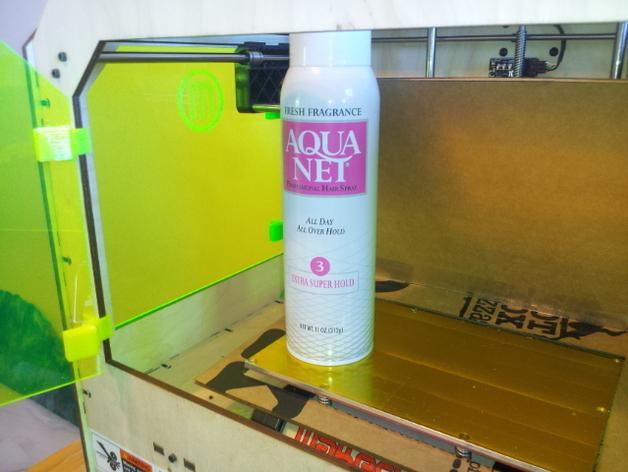Whenever there is an untimely death, the first thing we do is look around in an effort to understand how such a thing could have happened. When 17-year-old Tom Taylor was killed in an explosion that was linked to a 3D printer, the ears of the 3D printing community immediately perked up. The youth was using hairspray, something which has been touted in online forums as a way to create extra adhesion to a printer’s build plate. Unfortunately, this was ignited by a spark, whether from an outlet or from the printer itself is unclear, and the massive explosion took Taylor’s life.
One aspect of 3D printing that is the focus of a great deal of pride for the maker community is that even the printers themselves can be homemade. This is an area where the jerry-rigged is positively glorified, not something that is seen as quirky or abnormal. Given this, these kinds of household tips and tricks are a regular part of many people’s interactions with 3D printing. In the wake of Taylor’s death, there has been a great deal of talk about what might have happened and what that may mean for at home DIY 3D print tinkerers.
Conversation in threads is often callous and insensitive – although I was pleasantly surprised, either by the moderate nature of the contributors or the moderators themselves, to find very little abuse tossed around in the reddit thread about the accident – but Taylor’s death does raise some important questions. The first reaction is often one which attempts to paint the victim as an imbecile; in this way, we protect ourselves from fear with the assumption that if we are smarter, we will be safe. After all, nearly anything can be fatal if you try hard enough, but is there more than a freak accident in this tragedy?
 There are some highly specific lessons to be learned from the incident. For example, Taylor was storing a large quantity of something known as flash paper near the printer when the explosion occurred. Flash paper, officially nitrate cellulose, is a special type of treated paper commonly used by magicians to create an instantaneous flame.
There are some highly specific lessons to be learned from the incident. For example, Taylor was storing a large quantity of something known as flash paper near the printer when the explosion occurred. Flash paper, officially nitrate cellulose, is a special type of treated paper commonly used by magicians to create an instantaneous flame.
Unfortunately, it has a history of tragic fire associated with it as it was used in X-ray film (until 1933) and movie films (until 1948), occasionally bursting into flames and destroying theaters and hospitals. Clearly, it is not something that should be stored near a potential fire…but the key to remember is that you have to know there is a potential to spark something before you can realize what you shouldn’t be storing. Nonetheless, lesson number 1: don’t store flammable material near electronics.
The second, and less unusual, lesson is that the use of hairspray for greater adhesion to the build plate is something that should be undertaken with a degree of caution. In fact, home 3D printing in general should probably be performed under better ventilation conditions than currently understood – if not to avoid explosions, then to dilute the fumes from printing, which may have long term health impacts of which we are as yet unaware.
Given the number of people who operate 3D printers in ways that are perfectly safe, plus those whose unsafe practices simply don’t have the luck of the draw to combine in horrific ways, it’s clearly not an issue that specifically requires addressing. How many other people are storing flash paper at all, much less near their 3D printer? How many of those people are using hairspray as a fixative? And of that very small number, how many will be exposed to a spark? The answer is that we may have already been through the only case. At least I hope so, and I hope that this won’t be used as a way to drive home based 3D printing into retreat. Given the conversation, however, I don’t think there is even the slightest danger of that. Discuss in the 3D Printer Safety forum at 3DPB.com. [Image: The Lincolnite]
Subscribe to Our Email Newsletter
Stay up-to-date on all the latest news from the 3D printing industry and receive information and offers from third party vendors.
You May Also Like
Printing Money Episode 17: Recent 3D Printing Deals, with Alex Kingsbury
Printing Money is back with Episode 17! Our host, NewCap Partners‘ Danny Piper, is joined by Alex Kingsbury for this episode, so you can prepare yourself for smart coverage laced...
Insights from Cantor Fitzgerald on AM’s Q1 2024 Landscape
A recent survey by Cantor Fitzgerald sheds light on the persistent challenges within the additive manufacturing (AM) industry in the first quarter of 2024. Based on responses from 38 industry...
3D Printing Financials: Xometry’s Scaling up and Strong Start to 2024
Xometry (Nasdaq: XMTR) kicked off 2024 with strong results, boosting its marketplace and technology to new heights. Both revenue and gross margin soared, fueled by an expanding global network of...
3D Printing Financials: Desktop Metal Targets Recovery Amid Net Losses and Revenue Downturn
Despite facing a decline in revenue and the persistent challenges of a tight economic climate, Desktop Metal (NYSE: DM) is making strides toward operational efficiency. The first quarter of 2024...


































